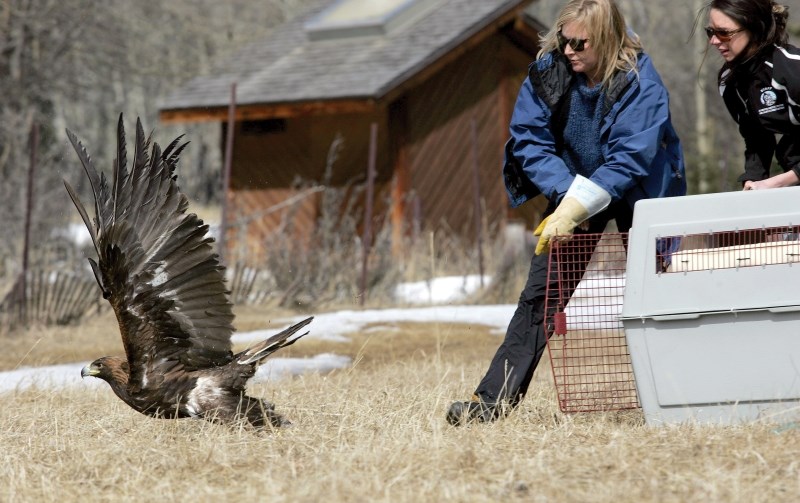A lead-poisoned golden eagle experienced an undignified return to freedom last weekend after being nursed back to health over the winter months.
Staff with the Alberta Institute for Wildlife Conservation, based in Madden, opened the door to a large crate used to transport the three-year-old male eagle to Hay Meadow near Nakiska Mountain Resort in Kananaskis Country on March 30 shortly after 1 p.m.
The eagle burst from the crate, its wings spread wide, ready to fly out into the meadow or nearby trees, but its progress was promptly halted when one of its feet got caught up in the mesh door of the crate.
Barbara Kowalzik, wildlife rehabilitation technician, freed the eagle’s foot and it flew a short distance away, skimming over a snow fence to land in a meadow where it hunkered down for the next few hours.
Not the start the 40-some people gathered at the site for its release expected.
“It wasn’t spectacular. We were hoping the eagle would leave the cage, take flight, do a circle, dip his wing in salute and disappear over the horizon. Well, that didn’t happen,” Cliff Hansen, an Exshaw resident and 10-year volunteer with The Rocky Mountain Eagle Research Foundation, said with a laugh on April 3.
After about two hours, Kowalzik flushed the eagle from his perch on the ground. He flew up, circled the clearing once and landed in a nearby aspen tree.
“He stayed there about another two hours and then on his own took flight, did another couple of circles and landed in a pine tree near us,” Hansen said. “I think he was confused by his newfound freedom and didn’t know what to do with it.”
No one saw the eagle fly away sometime before sunset as those who had come for the release had left and volunteers with The Rocky Mountain Eagle Research Foundation were back to counting raptors – most of which were golden eagles – passing overhead during their annual spring migration.
Renowned golden eagle researcher Peter Sherrington, who is credited with being the first scientist to document the golden eagle migration path that stretches over the eastern edge of the Rocky Mountains, said Saturday’s count had initially been quiet, with just eight golden eagles spotted. It became busy, however, after 5:20 p.m. when high overhead eagles began to appear, resulting in an additional 77 eagles spotted that day.
“We like to think he flew off and joined the cavalcade going north,” said Sherrington, who was not present at Hay Meadow on Saturday as he was counting eagles where he lives in the Crowsnest Pass.
But even if Sherrington and his volunteers didn’t have the pleasure of watching the juvenile eagle fly off, hopefully to join the migration, Hansen said it was satisfying just to see the bird healthy and out of captivity.
Fish and Wildlife officer Dave Dixon picked up the eagle west of Exshaw in early November. The emaciated, hypothermic and anemic bird was sent to the AIWC, where director of wildlife care and operations Dianne Wittner cared for him.
At the time, Wittner said the eagle, which came to the centre weighing 3.4 kilograms, had a grim prognosis. He had one of the highest levels of lead poisoning in an eagle that Wittner had treated at the centre.
“He was deathly ill and the biggest threat to him right off the bat, the first threat we had to address, was anemia,” Wittner said in early December. “If we looked at something else and didn’t focus on that, he probably would have died of anemia.”
Lead poisoning, which can cause organ failure, paralysis and blindness, along with numerous other symptoms, is difficult to treat in raptors, because it requires a constantly evolving treatment plan.
Wittner speculated the eagle likely ingested lead bullet fragments in a gut pile left behind by a hunter in the fall.
The golden eagle responded well to treatment and a steady diet of rabbits brought to the AIWC as part of Canmore’s feral rabbit trapping program and Wittner was eyeing the possibility of a winter release.




